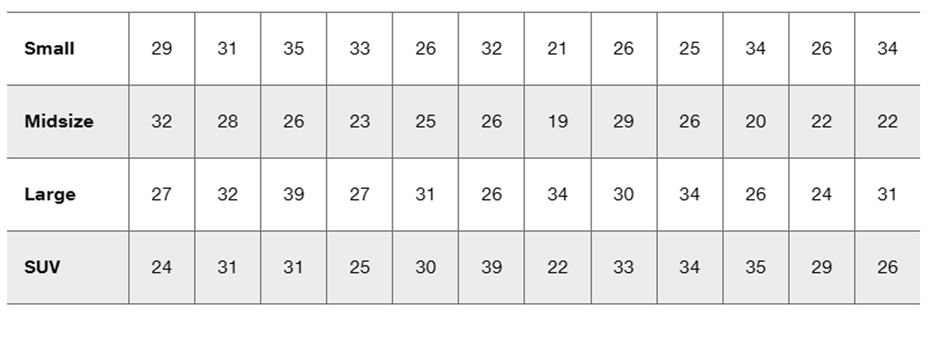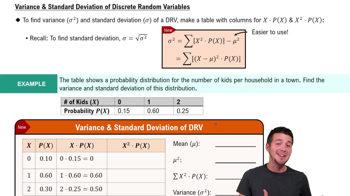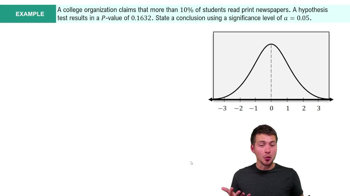Distance Between Pupils The following table lists distances (mm) between pupils of randomly selected U.S. Army personnel collected as part of the ANSUR II study. Results from two-way analysis of variance are also shown. Use the displayed results and use a 0.05 significance level. What do you conclude? Are the results as you would expect?
Table of contents
- 1. Intro to Stats and Collecting Data1h 14m
- 2. Describing Data with Tables and Graphs1h 55m
- 3. Describing Data Numerically2h 5m
- 4. Probability2h 16m
- 5. Binomial Distribution & Discrete Random Variables3h 6m
- 6. Normal Distribution and Continuous Random Variables2h 11m
- 7. Sampling Distributions & Confidence Intervals: Mean3h 23m
- Sampling Distribution of the Sample Mean and Central Limit Theorem19m
- Distribution of Sample Mean - Excel23m
- Introduction to Confidence Intervals15m
- Confidence Intervals for Population Mean1h 18m
- Determining the Minimum Sample Size Required12m
- Finding Probabilities and T Critical Values - Excel28m
- Confidence Intervals for Population Means - Excel25m
- 8. Sampling Distributions & Confidence Intervals: Proportion1h 12m
- 9. Hypothesis Testing for One Sample3h 29m
- 10. Hypothesis Testing for Two Samples4h 50m
- Two Proportions1h 13m
- Two Proportions Hypothesis Test - Excel28m
- Two Means - Unknown, Unequal Variance1h 3m
- Two Means - Unknown Variances Hypothesis Test - Excel12m
- Two Means - Unknown, Equal Variance15m
- Two Means - Unknown, Equal Variances Hypothesis Test - Excel9m
- Two Means - Known Variance12m
- Two Means - Sigma Known Hypothesis Test - Excel21m
- Two Means - Matched Pairs (Dependent Samples)42m
- Matched Pairs Hypothesis Test - Excel12m
- 11. Correlation1h 6m
- 12. Regression1h 50m
- 13. Chi-Square Tests & Goodness of Fit1h 57m
- 14. ANOVA1h 57m
9. Hypothesis Testing for One Sample
Steps in Hypothesis Testing
Problem 12.1.1b
Textbook Question
In Exercises 1–4, use the following listed measured amounts of chest compression (mm) from car crash tests (from Data Set 35 “Car Data” in Appendix B). Also shown are the SPSS results from analysis of variance. Assume that we plan to use a 0.05 significance level to test the claim that the different car sizes have the same mean amount of chest compression.

Anova
b. If the objective is to test the claim that the four car sizes have the same mean chest compression, why is the method referred to as analysis of variance?
 Verified step by step guidance
Verified step by step guidance1
Step 1: Understand the problem. The goal is to test the claim that the four car sizes (Small, Midsize, Large, SUV) have the same mean chest compression using a 0.05 significance level. The method used is analysis of variance (ANOVA).
Step 2: Recognize why the method is called analysis of variance. ANOVA is used to compare means of multiple groups by analyzing the variability within each group and between groups. It determines if the observed differences in sample means are statistically significant.
Step 3: Organize the data. The table provides chest compression measurements for four car sizes. Each row corresponds to a car size, and each column represents a measurement. Calculate the mean and variance for each group (Small, Midsize, Large, SUV).
Step 4: Perform ANOVA. Compute the between-group variance (how much the group means differ from the overall mean) and the within-group variance (how much individual measurements differ within each group). Use these variances to calculate the F-statistic.
Step 5: Compare the F-statistic to the critical value at the 0.05 significance level. If the F-statistic exceeds the critical value, reject the null hypothesis that all group means are equal. Otherwise, fail to reject the null hypothesis.
 Verified video answer for a similar problem:
Verified video answer for a similar problem:This video solution was recommended by our tutors as helpful for the problem above
Video duration:
3mPlay a video:
Was this helpful?
Key Concepts
Here are the essential concepts you must grasp in order to answer the question correctly.
Analysis of Variance (ANOVA)
ANOVA is a statistical method used to compare the means of three or more groups to determine if at least one group mean is significantly different from the others. It assesses the impact of one or more factors by comparing the variance within groups to the variance between groups. In this context, it helps to test the claim that different car sizes have the same mean amount of chest compression.
Recommended video:
Guided course

Variance & Standard Deviation of Discrete Random Variables
Null Hypothesis
The null hypothesis is a statement that there is no effect or no difference, and it serves as the default assumption in hypothesis testing. In this case, the null hypothesis would state that the mean chest compression measurements for small, midsize, large, and SUV cars are equal. The goal of the ANOVA test is to determine whether there is enough evidence to reject this null hypothesis.
Recommended video:
Guided course

Step 1: Write Hypotheses
Significance Level
The significance level, often denoted as alpha (α), is the threshold for determining whether a result is statistically significant. In this scenario, a significance level of 0.05 indicates that there is a 5% risk of concluding that a difference exists when there is none. If the p-value obtained from the ANOVA test is less than 0.05, it suggests that the means of the car sizes are significantly different.
Recommended video:
Guided course

Step 4: State Conclusion Example 4

 6:21m
6:21mWatch next
Master Step 1: Write Hypotheses with a bite sized video explanation from Patrick
Start learningRelated Videos
Related Practice
Textbook Question
